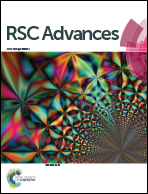Simultaneous adsorption of Cd2+ and reactive dye on mesoporous nanocarbons†
Abstract
High-surface-area mesoporous MgO-templated nanocarbons made with reinforcing fibres from scrap tyres and a bituminous waste as carbon precursors were employed for the simultaneous adsorption of Cd2+ and reactive Cibacron Brilliant Yellow 3G-P dye. A commercial activated carbon (AC) Darco KB-WJ was also used for comparison purposes. The effect of the pH of the solution was studied to establish whether acidic pH favours the adsorption of reactive dye and alkaline pH improves the removal of Cd2+. Because the surface chemistry of the three adsorbents was similar, the focus in this study was directed towards their textural characteristics. It was found that the larger the SBET, the greater the amount of dye removal. The adsorption isotherms corresponding to the commercial AC fitted to the Langmuir–Freundlich model, whereas in the case of the nanocarbons the Langmuir model provided the best fit. The results obtained show that Cd2+ is successfully adsorbed in the presence of the dye due to the ion exchange between the Na+ from the dye and the Cd2+. It was also found that a high total and mesopore volume, and a high SBET played a determinant role in the simultaneous adsorption.


 Please wait while we load your content...
Please wait while we load your content...